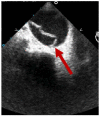Blunt Thoracic Aortic Injury
- PMID: 37109240
- PMCID: PMC10142366
- DOI: 10.3390/jcm12082903
Blunt Thoracic Aortic Injury
Abstract
Blunt thoracic aortic injury (BTAI) is a potentially fatal condition that needs prompt recognition and expedited management. Clinical manifestations of BTAI are not straight forwarding and may be misdiagnosed. The grade of aortic injury is an important determinant of perioperative mortality and morbidity, as well as the indication of treatment, along with the presence of concomitant lesions of other involved organs. The mainstay of treatment nowadays for hemodynamically stable patients who survive the trauma scene is represented by delayed endovascular repair whenever anatomically and clinically feasible. Endovascular repair, in fact, is burdened by lower perioperative mortality and morbidity rates if compared to open surgical repair, but concerns remain about the need for long-term surveillance and radiation exposure in patients who are at a younger age than patients treated for the aneurysmal disease. The aim of the paper is to provide an update on the diagnostic modalities and strategies of treatment for patients affected by BTAI.
Keywords: aortic; blunt injury; endovascular; thoracic; trauma.
Conflict of interest statement
The authors declare no conflict of interest.
Figures





